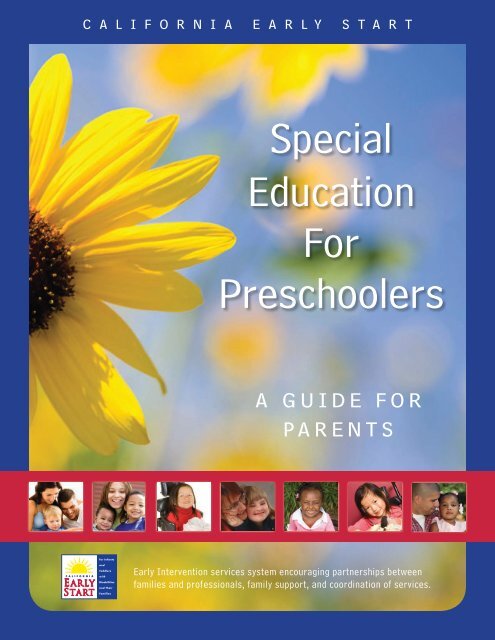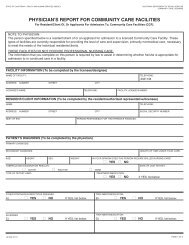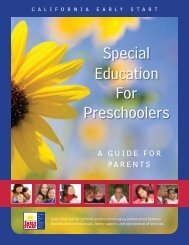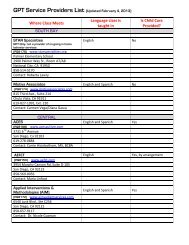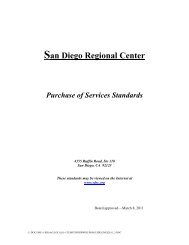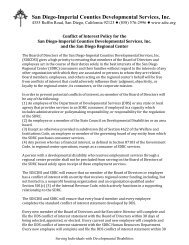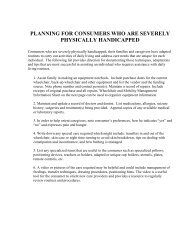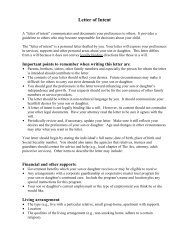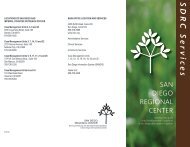Special Education For Preschoolers - San Diego Regional Center
Special Education For Preschoolers - San Diego Regional Center
Special Education For Preschoolers - San Diego Regional Center
Create successful ePaper yourself
Turn your PDF publications into a flip-book with our unique Google optimized e-Paper software.
C A L I F O R N I A E A R L Y S T A R T<br />
<strong>Special</strong><br />
<strong>Education</strong><br />
<strong>For</strong><br />
<strong>Preschoolers</strong><br />
A GUIDE FOR<br />
PARENTS<br />
Early Intervention services system encouraging partnerships between<br />
families and professionals, family support, and coordination of services.
Table of Contents<br />
Contacts..............................…………………………………………………….…………1<br />
Timelines...........................................................................................................................2<br />
Introduction (Dear Parents)…………………………………………………….…………3<br />
What is <strong>Special</strong> <strong>Education</strong>................................................................................................4<br />
What Does IDEA Provide.................................................................................................4<br />
Differences Between Infant/Toddler and Preschool Programs.............................................5<br />
Assessment Procedures......................................................................................................6<br />
Determining Eligibility for <strong>Special</strong> <strong>Education</strong> ...................................................................7<br />
What is the Purpose of an IEP..........................................................................................8<br />
Parent Involvement in <strong>Education</strong> Decisions.......................................................................9<br />
The Individualized <strong>Education</strong> Plan (IEP)...........................................................................9<br />
What Are the Components of an IEP ............................................................................10<br />
Least Restrictive Environment (LRE)...............................................................................11<br />
<strong>Education</strong>al Settings........................................................................................................11<br />
Community Settings.....................................……………………………………....…….12<br />
<strong>Special</strong> <strong>Education</strong> Preschool............................................................................................13<br />
Parent Rights and Procedural Safeguards.....……………………………..……....…....…14<br />
You Have Responsibilities, Too....................……………………………..……....…....…14<br />
Acknowledgements……………...................................…………………………..……..15
1<br />
E A R L Y S T A R T T R A N S I T I O N<br />
Names, Numbers and Dates to Remember:<br />
Contacts:<br />
Early Start Service Coordinator: __________________________________<br />
Phone Number: _______________________________________________<br />
Early Start Program Manager: ____________________________________<br />
Phone Number: _______________________________________________<br />
SDRC Service Coordinator: _____________________________________<br />
Phone Number: _______________________________________________<br />
SDRC Program Manager: _______________________________________<br />
Phone Number: _______________________________________________<br />
<strong>Education</strong> Contact: ____________________________________________<br />
Phone Number: _______________________________________________<br />
Exceptional Family Resource <strong>Center</strong> Contact: ________________________<br />
Phone Number: _______________________________________________<br />
Scheduled Evaluations/Meetings:<br />
Medical Evaluation (if applicable):<br />
Date: ________________ Time: _________________<br />
Developmental/Psychological Evaluation:<br />
Date: ________________ Time: _________________<br />
Final Review of IFSP:<br />
Date: ________________ Time: _________________<br />
Other Meetings:<br />
_________________________________________________________<br />
_________________________________________________________<br />
_________________________________________________________
E A R L Y S T A R T T R A N S I T I O N<br />
2<br />
Transition Year Timelines<br />
Child turns 2 years old<br />
• A goal is written on the Individualized Family Service Plan (IFSP)<br />
that transition planning activities will occur<br />
• “Early Start Transition for Parents” booklet is offered to family<br />
• Permission to share child information with district is signed<br />
Around 2 years six months<br />
• IFSP periodic review<br />
• “<strong>Special</strong> <strong>Education</strong> Services for <strong>Preschoolers</strong>” booklet offered to family<br />
• Service coordinator schedules IFSP for transition conference meeting<br />
Around 2 years nine months (or as early as 2 ½ )<br />
• Transition Planning Meeting with representatives from school districts,<br />
Head Start, etc. to explain their services to family<br />
By 2 years 10 months<br />
• Family receives an Assessment Plan from district Family signs and<br />
returns Assessment Plan beginning 60 day timeline<br />
Before Third birthday<br />
• IEP meeting is held and if child is eligible IEP is written<br />
Third birthday<br />
• Child begins services<br />
*Children referred between 2 years 10 months and 3 years old are offered booklets at first meeting
3<br />
E A R L Y S T A R T T R A N S I T I O N<br />
Dear Parents,<br />
This booklet is all about special education and what you need to know to<br />
make it a positive experience for your child. You will want to understand the<br />
processes and procedures that will occur, as well as your rights as a parent,<br />
in order to make decisions and actively participate in the meetings. There<br />
may be a number of new terms that you are not familiar with, but continue<br />
reading and the term will be explained in more detail.<br />
During the last six months that your child is in Early Start, a specific timeline<br />
of procedures is required. There will be decisions you want to participate in<br />
that may lead up to a referral to special education and culminate in developing<br />
an Individualized <strong>Education</strong> Plan (IEP) for your child. Your partnership<br />
with the professionals during this process is critical. As you are an important<br />
member of the team and know your child best, be sure to ask any questions<br />
you have and provide any information you feel is pertinent.<br />
Moving from the Early Start program may be unsettling. Many things are<br />
changing at once. You will be learning new terms and beginning relationships<br />
with new people. Help your child to begin his/her new experience by staying<br />
positive and taking care of yourself. It may help to remember that the<br />
decisions you make now do not have to be permanent. It’s okay to make<br />
plans and change them later if you need to.<br />
In additional to reading this booklet, you may want to talk with someone who<br />
is familiar with the special education system. You can ask your service provider<br />
or staff at the school district for more information. You may also call the<br />
Exceptional Family Resource <strong>Center</strong> (EFRC) to speak to a parent who has been<br />
through the process with their own child. We all want your child to progress<br />
in the upcoming years and to support you through the educational process.<br />
Your District’s <strong>Special</strong> <strong>Education</strong> Staff and EFRC
E A R L Y S T A R T T R A N S I T I O N 22 4<br />
What is <strong>Special</strong> <strong>Education</strong><br />
<strong>Special</strong> education, part of the public education system, is instruction and related services<br />
designed, at no cost to you, to meet your child’s unique educational needs, which cannot<br />
be met through modification of the general education curriculum. It provides a continuum<br />
of service options to meet the educational needs of children with disabilities in the<br />
least restrictive environment. <strong>Special</strong> education provides your child specially designed<br />
instruction to enable him/her to progress. Your rights and protection for these services<br />
are guaranteed under the Individuals with Disabilities <strong>Education</strong> Act. (2004),<br />
a federal law referred to as IDEA.<br />
What Does IDEA Provide<br />
The six primary components of IDEA are:<br />
1. Assessment/Evaluation Procedures<br />
Assessment/evaluation is the first step in determining if your child is eligible for<br />
special education. No assessment may be conducted without your written<br />
consent on the Assessment Plan.<br />
2. Parent Involvement in <strong>Education</strong>al Decisions<br />
The law provides for your involvement in the assessment process and at the IEP<br />
meeting. You are an essential part of the IEP team. It is important to ask<br />
questions and share your perspective at all times.<br />
3. Placement in the “Least Restrictive Environment” (LRE)<br />
IDEA requires that your child be educated in the LRE, that environment which<br />
is as close as possible to general education with children who are not disabled.<br />
LRE is determined by the IEP team, and may or may not be in a general<br />
education classroom setting.<br />
4. A Free and Appropriate Public <strong>Education</strong> (FAPE)<br />
IDEA ensures your child with special needs, between the ages of 0-22 years,<br />
receives an educational program specially designed to meet his or her unique<br />
needs, provided at no cost to you.<br />
5. A Written Individualized <strong>Education</strong> Program (IEP)<br />
Before your child receives special education services, a written IEP is developed.<br />
It is reviewed at least annually at a meeting in which you attend and participate.<br />
<strong>Special</strong> education services begin only after you agree to and sign the IEP.<br />
6. The Right of Due Process, if there is a Dispute<br />
This is a safeguard that protects your rights as a parent or guardian to disagree<br />
with educational decisions made for your child.
5<br />
E A R L Y S T A R T T R A N S I T I O N<br />
Differences Between Infant/Toddler<br />
and Preschool Programs<br />
Early Start infant/toddler programs are based on a model where services are<br />
delivered in natural environments such as community settings or at home.<br />
Infants and their families receive early intervention services individually<br />
or in small groups. Emphasis is placed on providing support to the parent<br />
and child through the help of a “service coordinator”. The focus of Early<br />
Start is on the child and family, while the goal is to assist parents in<br />
supporting the growth and development of their child with special needs.<br />
When your child begins a preschool program, the emphasis shifts to an<br />
educational model which focuses solely on your child. The emphasis of<br />
the preschool program will be on meeting your child’s unique needs.<br />
The preschool curriculum is based on the California Preschool Standards<br />
which focus on social interaction with children and adults, language<br />
development, and other pre-academic skills. Teaching activities in<br />
preschool generally occur in a large group, small groups, and/or at<br />
learning centers. Your child may receive some individual instruction<br />
and/or service to address goals developed in the IEP.<br />
Length of Day and Number of Days Per Week:<br />
The schedule for your child’s preschool program will probably be quite<br />
different from the infant program. Generally, preschool programs meet<br />
two to five half-days per week. The amount of time your child spends<br />
in preschool is dependent on his/her needs and is not the same<br />
for all children.<br />
Location of the Program:<br />
Sites for special education preschool programs may vary. Your child will<br />
be provided opportunities to participate in a variety of activities with<br />
children without disabilities to the extent that is appropriate.
E A R L Y S T A R T T R A N S I T I O N 6<br />
Assessment Procedures<br />
The goal of the school district’s assessment team is to obtain information about your child.<br />
This information is used to determine if your child is eligible for special education and to<br />
identify his/her areas of need. An assessment (sometimes referred to as an evaluation) is a<br />
way of looking at the whole child to learn about his or her strengths and areas of need.<br />
You are an important member of the team, and you can provide valuable information about<br />
your child. Remember, your child will be assessed only in the areas of concern. You may want<br />
to share with staff assessment or developmental assessments completed by other agencies.<br />
No testing will occur until you have been notified of the types of assessments to be done and<br />
you give your written consent for the assessment. A Case Manager from the school district<br />
will send you paperwork requesting you to give written consent for district staff to assess your<br />
child. The assessment plan (or evaluation plan) identifies the areas of need to be assessed such<br />
as communication, academic, motor, health, etc, and the specialist who will administer them.<br />
If you feel an area of need has not been addressed, be sure to contact the case manager to<br />
discuss your concerns. You will also be given a copy of Parent Rights and Procedural Safeguards<br />
that describe your rights in the assessment and education of your child.<br />
Assessments typically include the following:<br />
• Observations by staff who have worked with your child.<br />
• Medical history, when it’s relevant to your child’s performance in school.<br />
• Information you provide about your child’s previous school experiences, abilities,<br />
behavior outside of the school setting, and feelings about school.<br />
• When standardized tests are considered inappropriate for children ages three through<br />
five years, alternative procedures may be used, such as developmental checklists,<br />
observations and interviews.<br />
• A variety of assessment procedures may be used to assess your child: Your child may<br />
be seen individually with different members of the assessment team, or you and your<br />
child may be involved with all of the team members during one appointment.<br />
Remember, you’ve known your child longer than anyone, and you observe him/her in<br />
many different situations. You have important information to offer!
7<br />
E A R L Y S T A R T T R A N S I T I O N<br />
The assessment forms the basis for your child’s educational plan. <strong>For</strong> that reason,<br />
it is important that you, as the parent, participate to ensure that an accurate picture<br />
of your child is obtained. All tests are administered by qualified personnel, and a<br />
variety of assessments procedures will be used. Tests are an important part of<br />
the assessment process and are comprehensive. Your child will be assessed in<br />
his/her primary language, or other mode of communication, in a way that<br />
doesn’t discriminate in terms of disability or racial/cultural background.<br />
If you agree with the Assessment Plan, as soon as possible sign, date and return<br />
it to the school district staff member who prepared and sent the materials. The<br />
assessment cannot proceed until it is received. Once the District receives your<br />
signed Assessment Plan, District staff will schedule the assessment. An IEP<br />
meeting must be held within 60 calendar days of receipt of your written<br />
consent (not counting school recess days in excess of 5 school days).<br />
Determining Eligibility for <strong>Special</strong> <strong>Education</strong><br />
Eligibility for special education services at age 3 years is determined by the<br />
IEP team based on the results of the assessment of your child. Your child<br />
is eligible if, based upon assessment results, he/she meets the California<br />
<strong>Education</strong> Code eligibility criteria for one of the following 13 disabilities:<br />
• Autism<br />
• Deaf<br />
• Deaf-blind<br />
• Emotional disturbance<br />
• Hearing impairment<br />
• Mental retardation<br />
• Multiple disabilities<br />
• Orthopedic impairment<br />
• Other health impairment<br />
• Specific learning disability<br />
• Speech or language impairment<br />
• Traumatic brain injury<br />
• Visual impairment
E A R L Y S T A R T T R A N S I T I O N 8<br />
What is the Purpose of an IEP<br />
Once a child has been referred and an assessment completed, an IEP meeting is held. The<br />
IEP meeting has several purposes. The team shares the assessment information to determine<br />
if your child meets eligibility criteria specified by the state to be considered a child with a<br />
disability. If a child is eligible for special education, the second purpose is to develop<br />
measurable annual goals in the areas of your child’s identified needs. The third purpose of an<br />
IEP meeting is to ensure that appropriate special education services are identified to address<br />
your child’s needs. At the conclusion of the IEP meeting, you may request to observe the<br />
proposed educational program. If your child is eligible to receive services through the school<br />
district, you will need to register/enroll your child at the school.<br />
What is the Team Approach<br />
The team approach is the cooperative effort between you and the various specialists to<br />
develop the IEP that meets your child’s needs. You are an important part of the team. At the<br />
IEP meeting, the IEP team reviews assessment results, determines eligibility, and develops the<br />
IEP. The meeting is held at the school at a time that is mutually agreeable to parents and staff.<br />
Teachers and other specialists keep records of your child’s service and progress. You will be<br />
informed of your child’s progress three to four times a year.<br />
Who Participates in an IEP Meeting<br />
It is required that the following individuals participate at an IEP meeting:<br />
• You, the parent or guardian<br />
• A district designee<br />
• A special education provider (such as a special education teacher,<br />
speech pathologist, etc.).<br />
• A general education teacher<br />
• The staff who have assessed your child, or someone who understands<br />
the assessment procedures used with your child and is familiar with the results<br />
• Other members may include those determined by the school (e.g., interpreter,<br />
psychologist, counselor)<br />
• Other individuals you invite to the meeting who have knowledge of your<br />
child (e.g., friend of parents, or a <strong>Regional</strong> <strong>Center</strong> representative if your<br />
child is a <strong>Regional</strong> <strong>Center</strong> client)
9<br />
E A R L Y S T A R T T R A N S I T I O N<br />
Parent Involvement in <strong>Education</strong> Decisions<br />
It is important that you be an involved participant in the decision-making<br />
process at all phases of your child’s education. You are an essential member<br />
of the team that helps to develop the services necessary and the goals your<br />
child will work toward to address his/her needs. Your knowledge of your<br />
child is essential in developing an educational plan.<br />
The Individualized <strong>Education</strong> Plan (IEP)<br />
The IEP is a document that is written for each child with a disability between<br />
the ages of 3-22 years, who is eligible to receive special education. It is<br />
developed by your child’s team and guarantees delivery of appropriate<br />
services for children who meet eligibility requirements. It identifies the<br />
strengths and areas of need(s) of your child as well as the goals and objectives<br />
to address those needs. It also includes other information discussed during<br />
the IEP meeting. The IEP is a plan that is typically written for a year. A copy<br />
of the IEP will be given to you at the end of the meeting.<br />
Each person who participates in the IEP meeting will be asked to sign the IEP.<br />
If you are unsure about the appropriateness of the team’s recommendations<br />
you may:<br />
1. Think about it for a few days<br />
2. Express your disagreement so that more discussion may occur; or,<br />
3. Indicate the parts with which you do agree.<br />
If you have concerns about the IEP and do not sign, you may sign that you<br />
were “In Attendance”. If you disagree with any of the recommendations<br />
regarding your child’s services, and are unable to resolve the issue, your<br />
procedural safeguards (parent’s rights) enable you to exercise your right to<br />
due process. If you need assistance, a district representative is required to<br />
help you with this process. Because districts prefer to work collaboratively<br />
with parents, you are encouraged to contact the District’s Program <strong>Special</strong>ist<br />
or Director of special education if you feel that a disagreement cannot be<br />
resolved with the team. School districts may have personnel and/or services<br />
to help you resolve disagreements.<br />
Remember: You may change your mind and decide you do not want <strong>Special</strong><br />
<strong>Education</strong> services for you child without being concerned that district or<br />
<strong>Regional</strong> <strong>Center</strong> staff will object.
E A R L Y S T A R T T R A N S I T I O N 10<br />
What Are the Components of an IEP<br />
1. Your Child’s Present Level of Performance<br />
These are statements describing your child’s strengths and areas of need based on<br />
assessment results. These statements describe your child skills and likely match<br />
your knowledge of your child’s abilities.<br />
2. Annual Long Term Goals<br />
Goals are developed based on the assessment information to address your child’s areas<br />
of need. They focus on skills and behaviors that your child and his/her teacher will<br />
target over the next school year (e.g. , Mary will match the basic colors; Bobby will<br />
use 2 word phrases to communicate his wants and needs). Your input will help<br />
determine if these goals are appropriate based on what you know about your child.<br />
3. <strong>Education</strong>al Services<br />
The IEP team determines the programs and/or services your child needs to benefit from<br />
his/her educational program. A statement of the extent to which your child will be<br />
included in the general education program is also in the IEP. Some meaningful contact<br />
with “typical” children the same age should be defined.<br />
4. Related Services<br />
Related services will be provided to a child who is found eligible for special education if<br />
they are identified by the school district’s IEP team to be educationally necessary for the<br />
child to benefit from his special education program. Related services include: adapted<br />
physical education (APE), audiological services, speech/language therapy, occupational<br />
therapy, orientation and mobility services, assistive technology, etc. Instruction may<br />
be provided at a local school or other community/education setting. The IEP will<br />
indicate the date the service begins, and how long it will last, the location, and how<br />
frequently it will be provided.<br />
5. Evaluation and Review<br />
The teacher(s) and other specialists who work with your child are responsible for<br />
designing learning tasks and activities to help your child achieve the goals. Although<br />
the goals are written, the IEP does not guarantee that the child will develop those skills.<br />
The IEP needs to be reviewed at an IEP team meeting at least once per year. At the<br />
annual meeting, you will receive information from your child’s teacher and or<br />
specialists about the progress your child has made. Sometimes, samples of your<br />
child’s work will be brought to the meeting to share with you. You may request an<br />
IEP meeting before a year, and one will be held within 30 days of your request.
11<br />
E A R L Y S T A R T T R A N S I T I O N<br />
Least Restrictive Environment (LRE)<br />
The federal and state laws that govern special education require that the IEP<br />
team provide programs and services in the Least Restrictive Environment<br />
(LRE). Least Restrictive Environment is defined as the setting that ensures<br />
your child is educated with typically developing children to the maximum<br />
extent appropriate. The concepts of “mainstreaming” and “inclusion” are<br />
based on Least Restrictive Environment.<br />
<strong>Education</strong>al Settings<br />
IDEA gives you the opportunity to decide, with the members of the IEP<br />
team, the least restrictive educational setting that will meet your child’s<br />
educational needs. Options may include:<br />
• <strong>Special</strong> instruction provided by a specialist in a public general<br />
education preschool classroom.<br />
• Related Service only: The setting for your child’s service may not<br />
always be a classroom. <strong>For</strong> example, if your child only receives<br />
speech therapy, the service may be provided at a local public school<br />
at scheduled dates and times.<br />
• Preschool <strong>Special</strong> <strong>Education</strong> classrooms: a setting for children<br />
with significant disabilities who need the majority of their special<br />
education service provided in a self-contained classroom.<br />
These classrooms are typically located at schools in the district.
E A R L Y S T A R T T R A N S I T I O N 12<br />
Community Public Preschool Options<br />
Within the community, there are a variety of public preschool options:<br />
Parent Participation Preschool Classes operated by the adult educational program<br />
are provided at some community colleges. These preschool classes allow parents or<br />
caregivers to participate with their child in a developmentally appropriate preschool<br />
program. A variety of class schedules are offered throughout the week. Parent<br />
participation in the program decreases as children get older so that the preschoolers<br />
have increasing experience in larger groups. Parents are able to learn skills for working<br />
with their child as well as get support from other parents in the program.<br />
Head Start is a federally funded preschool program that primarily serves children from<br />
families who meet income eligibility. Head Start is required to make available at least 10<br />
percent of all its funded slots to children with special needs. Some Head Starts provide<br />
transportation. Due to space limitations, Head Start gives priority to 4-year old children<br />
who meet income guidelines and to children who have special needs. There is no cost to<br />
parents for this program; however, parents are strongly encouraged to volunteer time in<br />
the classroom or on various advisory committees. It is helpful to invite a Head Start<br />
special education coordinator to your child’s transition IFSP meeting. If interested, have<br />
your Service Coordinator contact HS and arrange for their participation in the IEP.<br />
Child Development <strong>Center</strong>s are state- and federally-funded preschool programs<br />
provided by public, private and parochial agencies. These programs primarily serve<br />
parents who require childcare because they are working or in training for work. Eligibility<br />
is based upon the family income. A fee may be charged depending upon the family’s<br />
income level. <strong>Center</strong>s are generally open at 6:30 a.m. and closed between 5:30 and<br />
6:00 p.m. Children who are 2 ½ through preschool age are eligible. The facility must be<br />
licensed by the state department of social services community care licensing division.<br />
State Preschool Programs are operated in some local school districts. These programs<br />
are half-day preschool programs that provide developmentally appropriate instruction<br />
for children. Some state funded preschool programs have income requirements for<br />
families. Parent involvement is encouraged. More information about state funded and<br />
other district preschool programs is available from your local school district.
13<br />
E A R L Y S T A R T T R A N S I T I O N<br />
Private Preschool and Child Care Programs are operated by religious<br />
organizations and other private corporations. If your child is enrolled in a<br />
private preschool by your choice, you as the parent are responsible for your<br />
child’s tuition to attend that school. If it is determined that your child needs<br />
special education services, your school district representatives will provide you<br />
with information about special education service delivery for preschool-aged<br />
children enrolled in private preschools.<br />
Planning ahead is very important when public or private schools is<br />
desired, as many have waiting lists or enrollment periods that do not<br />
match your child’s birthday. It is recommended that you contact the<br />
program 6 months before your child’s 3rd birthday.<br />
<strong>Special</strong> <strong>Education</strong> Preschool<br />
<strong>Special</strong> education preschool classes are for children with disabilities who meet<br />
eligibility criteria specified by IDEA and whose needs require a self-contained<br />
class. Preschool programs may be provided up to five half-days per week,<br />
depending on the child’s individual needs. Classrooms are staffed by one<br />
certificated special education teacher and one or more paraprofessionals.<br />
Activities in the classroom are designed to help children reach the goals<br />
specified on their IEPs as well as to provide a stimulating developmentally<br />
appropriate preschool program. Related services are provided as determined<br />
by the IEP team. There is no cost to parents.<br />
Families may find it desirable to use a combination of programs for their child.<br />
Some children attend a special education preschool program two or three days<br />
per week and a community preschool program on other days. Some families<br />
choose to use other community resources, such as recreation or gymnastic<br />
classes, religious schools or informal social groups to provide for their child’s<br />
needs in addition to the school program. Because children have different needs,<br />
developing a combination program is a way to individualize and personalize<br />
services for a child with special needs.<br />
Talk with your school district’s representative if you have questions or would<br />
like more information about preschool options in your community.
E A R L Y S T A R T T R A N S I T I O N 14<br />
Parent Rights and Procedural Safeguards<br />
At the beginning of the assessment process, the District provides you with a copy of the<br />
Parents’ Rights and Procedural Safeguards. It is important for you to read and review them as<br />
they inform you of the process (from evaluation through IEP implementation) and the rights<br />
of your child as a special education student.<br />
The following is a very brief summary of your rights, although you will want to read them in<br />
their entirety. You have the right to:<br />
• Participate in the assessment and development of the IEP<br />
• Be informed of continuum of program options<br />
• Receive prior written notice when the district requests to initiate a change in the IEP<br />
• Decide if your child will be assessed or receive special education (you may<br />
refuse to consent)<br />
• Inspect, review and/or obtain copies of your child’s school record<br />
• Exercise due process, and, in such situations, are encouraged to participate<br />
in a resolution and mediation session<br />
You Have Responsibilities, Too…<br />
It is important for you to understand basic information about your rights and protections under<br />
special education law. It is also important for you to understand you also have responsibilities.<br />
You have the responsibility to:<br />
❑ Ask questions when you do not understand terms or reports<br />
❑ Become and remain an active member of the team<br />
❑ Share your perspective with accurate information about your child<br />
❑ Make suggestions about your child’s educational setting and services<br />
❑ Help your child grow and develop<br />
<strong>For</strong> more about parent rights and procedural safeguards, contact:<br />
Name: _________________________________________________________<br />
Title: __________________________________________________________<br />
Agency: ________________________________________________________<br />
Phone: _________________________________________________________<br />
Phone: _________________________________________________________<br />
Other: _________________________________________________________
15<br />
E A R L Y S T A R T T R A N S I T I O N<br />
Acknowledgements<br />
The <strong>San</strong> <strong>Diego</strong> Early Start Guides for Parents on Early Start Transition<br />
and Preschool <strong>Special</strong> <strong>Education</strong> were developed by members of the<br />
<strong>San</strong> <strong>Diego</strong> Countywide Early Start Transition Committee with input<br />
from the <strong>San</strong> <strong>Diego</strong> County Early Start Administrators Team and<br />
representatives from the Exceptional Family Resource <strong>Center</strong> (EFRC),<br />
<strong>San</strong> <strong>Diego</strong> <strong>Regional</strong> <strong>Center</strong>, and personnel from local school districts.<br />
We want to acknowledge the hours of effort on behalf of these members<br />
toward making this guide useful, meaningful, and accurate.<br />
A special thank you to our colleagues in the Los Angeles County Office<br />
of <strong>Education</strong> whose Early Start Transition: a Guide for Parents series was<br />
used as a reference model for format and content.<br />
We also wish to thank HOPE Infant Family Support Program for<br />
allocating funding to design and develop these guides and the<br />
Exceptional Family Resource <strong>Center</strong> for facilitating the process<br />
from design to dissemination.<br />
SAN DIEGO<br />
REGIONAL CENTER
Notes:
Transition/Preschool Guide 8/2010<br />
Exceptional Family Resource <strong>Center</strong><br />
9245 Sky Park Court Ste 130<br />
<strong>San</strong> <strong>Diego</strong>, California 92123<br />
(800) 281-8252


